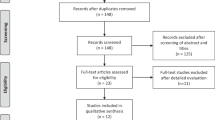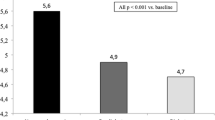Abstract
This study investigated the role of carotid artery intima-media thickness (IMT) as a morphological marker of the response of vasculogenic erectile dysfunction (ED) patients to tadalafil, one of the phosphodiesterase 5 inhibitor (PDE5-I). Through March–December 2016, 51 men with vasculogenic ED aged over 30 years were enrolled in this prospective study. Vasculogenic ED was accepted as a normal testosterone level, with penile colour Doppler ultrasonography showing arteriogenic ED, venogenic ED or mixed arteriogenic and venogenic ED. All patients underwent biochemical and hormonal blood tests, ultrasonographic evaluation of the common carotid artery (CCA) IMT and penile colour Doppler ultrasonography. On-demand tadalafil (10 mg or 20 mg in cases of a non-response to 10 mg) was administered to each patient for 2 months. ED was assessed using the short form of International Index of Erectile Function (IIEF-5) before and after the drug therapy. According to the patients’ responses to the medication, they were grouped as non-responders or responders. Thirty-one of the 51 patients responded to tadalafil. The mean CCA IMT of the non-responders and responders was 0.9 ± 0.2 mm and 0.6 ± 0.2 mm, respectively (P = 0.000). The IMT of 90% of the non-responders was >0.67 mm, whereas it was >0.67 mm in 40% of the responders. The data were analysed using the Kolmogorov–Smirnov test, Chi-square test, t-test, Mann–Whitney U test and receiver operator characteristic (ROC) curves. Measurement of CCA IMT may offer an alternative and simple method to predict the response of vasculogenic ED patients to PDE5-Is.
This is a preview of subscription content, access via your institution
Access options
Subscribe to this journal
Receive 8 print issues and online access
$259.00 per year
only $32.38 per issue
Buy this article
- Purchase on Springer Link
- Instant access to full article PDF
Prices may be subject to local taxes which are calculated during checkout



Similar content being viewed by others
References
NIH Consensus Conference. Impotence. NIH consensus development panel on impotence. JAMA. 1993;270:83.
Giuliano FA, Leriche A, Jaudinot EO, de Gendre AS. Prevalence of erectile dysfunction among 7689 patients with diabetes or hypertension, or both. Urology. 2004;64:1196–201.
Sullivan ME, Thompson CS, Dashwood MR, Khan MA, Jeremy JY, Morgan RJ, et al. Nitric oxide and penile erection: is erectile dysfunction another manifestation of vascular disease? Cardiovasc Res. 1999;43:658–65.
Mirone V, Imbimbo C, Bortolotti A, Di Cintio E, Colli E, Landoni M, et al. Cigarette smoking as risk factor for erectile dysfunction: results from an Italian epidemiological study. Eur Urol. 2002;41:294–7.
Corona G, Mannucci E, Schulman C, Petrone L, Mansani R, Cilotti A et al. Psychobiologic correlates of the metabolic syndrome and associated sexual dysfunction. Eur Urol. 2006;50:595–604.
Solomon H, Man JW, Jackson G. Erectile dysfunction and the cardiovascular patient: endothelial dysfunction is the common denominator. Heart. 2003;89:251–3.
van Popele NM, Grobbee DE, Bots ML, Asmar R, Topouchian J, Reneman RS et al.Association between arterial stiffness and atherosclerosis: the Rotterdam Study. Stroke. 2001;32:454–60.
Bocchio M, Scarpelli P, Necozione S, Pelliccione F, Mhialca R, Spartera C. et al. Intima-media thickening of common carotid arteries is a risk factor for severe erectile dysfunction in men with vascular risk factors but no clinical evidence of atherosclerosis. J Urol. 2005;173:526–9.
Chen SF, Yao FJ, Sun XZ, Wu RP, Huang YP, Zheng FF et al. Brachial artery flow-mediated dilatation and carotid intima-media thickness in young ED patients with insulin resistance. Int J Impot Res. 2016;28:194–9.
Eardley I, Donatucci C, Corbin J, El-Meliegy A, Hatzimouratidis K, McVary K, et al. Pharmacotherapy for erectile dysfunction. J Sex Med. 2010;7:524–40.
Curran M, Keating G. Tadalafil. Drugs. 2003;63:2203–12.
Vickers MA, Satyanarayana R. Phosphodiesterase type 5 inhibitors for the treatment of erectile dysfunction in patients with diabetes mellitus. Int J Impot Res. 2002;14:466–71.
Rosen RC. Psychogenic erectile dysfunction. Classification and management. Urol Clin North Am. 2001;28:269–78.
Rosen RC, Riley A, Wagner G, Osterloh IH, Kirkpatrick J, Mishra A. The International Index of Erectile function (IIEF): a multidimensional scale for assessment of erectile dysfunction. Urology. 1997;49:822–30.
Golijanin D, Singer E, Davis R, Bhatt S, Seftel A, Dogra V. Doppler evaluation of erectile dysfunction—part 1. Int J Impot Res. 2007;19:37–42.
Claes HI, Andrianne R, Opsomer R, Albert A, Patel S, Commers K. The HelpED study: agreement and impact of the erection hardness score on sexual function and psychosocial outcomes in men with erectile dysfunction and their partners. J Sex Med. 2012;9:2652–63.
Feldman HA, Goldstein I, Hatzichristou DG, Krane RJ, McKinlay JB. Impotence and its medical and psychosocial correlates: results of the Massachusetts Male Aging Study. J Urol 1994;151(1):54–61.
Feldman HA, Goldstein I, Hatzichristou DG, Krane RJ, Mckinlay JB. Impotence and its medical and psychosocial correlates: results of the Massachusetts Male Aging Study. J Urol. 1994;151:54–61.
Martín-Morales A, Sanchez-Cruz JJ, et al. Prevalence and independent risk factors for erectile dysfunction in Spain: results of the Epidemiologia de la Disfuncion Erectil Masculina study. J Urol. 2001;166:569–74.
Solomon H, Man JW, Wierzbicki AS, Jackson G. Relation of erectile dysfunction to angiographic coronary artery disease. Am J Cardiol. 2003;91:230–1.
Chai SJ, Barrett-Connor E, Gamst A. Small-vessel lower extremity arterial disease and erectile dysfunction: the Rancho Bernardo study. Atherosclerosis. 2009;203:620–5.
Bener A, AOAA Al-Hamaq, Kamran, Al-Ansari A. Prevalence of erectile dysfunction in male stroke patients, and associated co-morbidities and risk factors. Int Urol Nephrol. 2008;40:701–8.
Foresta C, Palego P, Schipilliti M, Selice R, Ferlin A, Caretta N. Asymmetric development of peripheral atherosclerosis in patients with erectile dysfunction: an ultrasonographic study. Atherosclerosis. 2008;197:889–95.
Chambless LE, Folsom AR, Davis V, et al. Risk factors for progression of common carotid atherosclerosis: the Atherosclerosis Risk in Communities Study, 1987–1998. Am J Epidemiol. 2002;155:38–47.
Feldman HA, Johannes CB, Derby CA, Kleinman KP, Mohr BA, Araujo AB et al. Erectile dysfunction and coronary risk factors: prospective results from the Massachusetts male aging study. Prev Med. 2000;30:328–38.
Goldstein I, Lue TF, Padma-Nathan H, Rosen RC, Steers WD, Wicker PA. Oral sildenafil in the treatment of erectile dysfunction. Sildenafil Study Group. N Engl J Med. 1998;338:1397–404.
Moreland RB, Goldstein I, Traish A. Sildenafil, a novel inhibitor of phosphodiesterase type 5 in human corpus cavernosum smooth muscle cells. Life Sci. 1998;62(PL):309–18.
Goldstein I, Lue TF, Padma-Nathan H, Rosen RC, Steers WD, Wicker PA. Sildenafil Study Group. Oral sildenafil in the treatment of erectile dysfunction. J Urol. 2002;167:1197.
Curran M, Keating G. Tadalafil—Drugs. 2003;63: 220–312.
Fonseca V, Seftel A, Denne J, Fredlund P. Impact of diabetes mellitus on the severity of erectile dysfunction and response to treatment: analysis of data from tadalafil clinical trials. Diabetologia. 2004;47:1914–23.
Gamidov SI, Mazo EB, Ovchinnikov RI, Andranovich SV, Iremashvili VV. Prediction of clinical efficacy of levitra (vardenafil) in patients with arteriogenic erectile dysfunction. Urologia. 2006;4:44–9.
Shefi S, Zwecker M, Pinthus JH, Mor Y, Zeilig G, Shemesh Y, et al. Bulbocavernosus reflex testing: a preliminary study on the prognostic factors for potency and response to sildenafil citrate after bilateral nerve-sparing radical prostatectomy. Int Urol Nephrol. 2010;42:39–45.
O’Leary DH, Polak JF, Kronmal RA, Manolio TA, Burke GL, Wolfson Jr SK. Carotidartery intima and media thickness as a risk factor for myocardial infarction and stroke in older adults. Cardiovascular Health Study Collaborative Research Group. N Engl J Med. 1999;340:14–22.
Liu L, Zhao F, Yang Y, Qi LT, Zhang BW, Chen F, et al. The clinical significance of carotid intima-media thickness in cardiovascular diseases: a survey in Beijing. J Hum Hypertens. 2008;22:259–65.
Caretta N, Palego P, Ferlin A, Garolla A, Bettella A, Selice R, et al. Resumption of spontaneous erections in selected patients affected by erectile dysfunction and various degrees of carotid wall alteration: role of tadalafil. Eur Urol. 2005;48:326-31–331-2.
Yan RT, Anderson TJ, Charbonneau F, Title L, Verma S, Lonn E. Relationship between carotid artery intima-media thickness and brachial artery flow-mediated dilation in middle aged healthy men. J Am Coll Cardiol. 2005;45:1980–6.
Acknowledgements
Any kind of financial support had no role in study design, data collection, data analysis, data interpretation or writing the report.
Author information
Authors and Affiliations
Corresponding author
Ethics declarations
Conflict of interest
The authors declare that they have no conflict of interest.
Additional information
Publisher’s note: Springer Nature remains neutral with regard to jurisdictional claims in published maps and institutional affiliations.
Rights and permissions
About this article
Cite this article
Pelit, E.S., Dokumacı, D.Ş., Kati, B. et al. Carotid artery intima-media thickness can predict the response of patients with erectile dysfunction to phosphodiesterase 5 inhibitors. Int J Impot Res 31, 139–144 (2019). https://doi.org/10.1038/s41443-018-0103-x
Received:
Revised:
Accepted:
Published:
Issue Date:
DOI: https://doi.org/10.1038/s41443-018-0103-x



